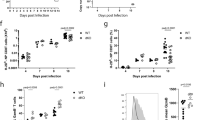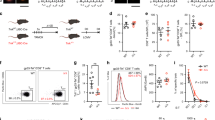Abstract
Pre-T cell antigen receptor (pre-TCR) signaling plays a crucial role in the development of immature T cells. Although certain aspects of proximal pre-TCR signaling have been studied, the intermediate signal transducers and the distal transcription modulators have been poorly characterized. We report here a correlation between pre-TCR signaling and a biphasic rise in the cytosolic Ca2+ concentration. In addition, we show that constitutive pre-TCR signaling is associated with an increased rate of Ca2+ influx through store-operated plasma membrane Ca2+ channels. We show also that the biphasic nature of the observed pre-TCR–induced rise in cytosolic Ca2+ differentially modulates the activities of the transcription factors NF-κB and NFAT in developing T cells.
This is a preview of subscription content, access via your institution
Access options
Subscribe to this journal
Receive 12 print issues and online access
$209.00 per year
only $17.42 per issue
Buy this article
- Purchase on Springer Link
- Instant access to full article PDF
Prices may be subject to local taxes which are calculated during checkout







Similar content being viewed by others
References
von Boehmer, H. & Fehling, H. J. Structure and function of the pre-T cell receptor. Annu. Rev. Immunol. 15, 433–452 (1997).
Aifantis, I., Buer, J., von Boehmer, H. & Azogui, O. Essential role of the pre-T cell receptor in allelic exclusion of the T cell receptor β locus. Immunity 7, 601–607 (1997).
Hoffman, E. S. et al. Productive T-cell receptor β-chain gene rearrangement: coincident regulation of cell cycle and clonality during development in vivo. Genes Dev. 10, 948–962 (1996).
Aifantis, I. et al. Allelic exclusion of the T cell receptor β locus requires the SH2 domain-containing leukocyte protein (SLP)-76 adaptor protein. J. Exp. Med. 190, 1093–1102 (1999).
Irving, B. A., Alt, F. W. & Killeen, N. Thymocyte development in the absence of pre-T cell receptor extracellular immunoglobulin domains. Science 280, 905–908 (1998).
Saint-Ruf, C. et al. Different initiation of pre-TCR and γδTCR signalling. Nature 406, 524–527 (2000).
von Boehmer, H. et al. Pleiotropic changes controlled by the pre-T cell receptor. Curr. Opin. Immunol. 11, 135–142 (1999).
Fischer, A. & Malissen, B. Natural and engineered disorders of lymphocyte development. Science 280, 237–243 (1998).
Karin, M. & Ben-Neriah, Y. Phosphorylation meets ubiquitination: the control of NF-κB activity. Annu. Rev. Immunol. 18, 621–663 (2000).
Attar, R. M. et al. Genetic approaches to study Rel/NF-κB/IκB function in mice. Semin. Cancer Biol. 8, 93–101 (1997).
Horwitz, B. H., Scott, M. L., Cherry, S. R., Bronson, R. T. & Baltimore, D. Failure of lymphopoiesis after adoptive transfer of NF-κB–deficient fetal liver cells. Immunity 6, 765–772 (1997).
Bakker, T. R., Renno, T. & Jongeneel, C. V. Impaired fetal thymocyte development after efficient adenovirus-mediated inhibition of NF-κB activation. J. Immunol. 162, 3456–3462 (1999).
Voll, R. E. et al. NF-κB activation by the pre-T cell receptor serves as a selective survival signal in T lymphocyte development. Immunity 13, 677–689 (2000).
Crabtree, G. R. & Clipstone, N. A. Signal transmission between the plasma membrane and nucleus of T lymphocytes. Annu. Rev. Biochem. 63, 1045–1083 (1994).
Grakoui, A. et al. The immunological synapse: a molecular machine controlling T cell activation. Science 285, 221–217 (1999).
Valge, V. E., Wong, J. G., Datlof, B. M., Sinskey, A. J. & Rao, A. Protein kinase C is required for responses to T cell receptor ligands but not to interleukin-2 in T cells. Cell 55, 101–112 (1988).
Schaeffer, E. M. & Schwartzberg, P. L. Tec family kinases in lymphocyte signaling and function. Curr. Opin. Immunol. 12, 282–288 (2000).
Putney, J. W. Jr Capacitative calcium entry revisited. Cell Calcium 11, 611–624 (1990).
Putney, J. W. Jr & McKay, R. R. Capacitative calcium entry channels. Bioessays 21, 38–46 (1999).
Hoth, M. & Penner, R. Depletion of intracellular calcium stores activates a calcium current in mast cells. Nature 355, 353–356 (1992).
Partiseti, M. et al. The calcium current activated by T cell receptor and store depletion in human lymphocytes is absent in a primary immunodeficiency. J. Biol. Chem. 269, 32327–32335 (1994).
Rao, A., Luo, C. & Hogan, P. G. Transcription factors of the NFAT family: regulation and function. Annu. Rev. Immunol. 15, 707–747 (1997).
Dolmetsch, R. E., Lewis, R. S., Goodnow, C. C. & Healy, J. I. Differential activation of transcription factors induced by Ca2+ response amplitude and duration. Nature 386, 855–858 (1997).
Levelt, C. N., Ehrfeld, A. & Eichmann, K. Regulation of thymocyte development through CD3. I. Timepoint of ligation of CD3ɛ determines clonal deletion or induction of developmental program. J. Exp. Med. 177, 707–716 (1993).
Shinkai, Y. & Alt, F. W. CD3 epsilon-mediated signals rescue the development of CD4+CD8+ thymocytes in RAG-2−/− mice in the absence of TCRβ chain expression. Int. Immunol. 6, 995–1001 (1994).
Groettrup, M. et al. A novel disulfide-linked heterodimer on pre-T cells consists of the T cell receptor β chain and a 33 kd glycoprotein. Cell 75, 283–294 (1993).
Henkel, T. et al. Rapid proteolysis of IκB-α is necessary for activation of transcription factor NF-κB. Nature 365, 182–185 (1993).
Kiani, A., Rao, A. & Aramburu, J. Manipulating immune responses with immunosuppressive agents that target NFAT. Immunity 12, 359–372 (2000).
Baeuerle, P. A. & Henkel, T. Function and activation of NF-κB in the immune system. Annu. Rev. Immunol. 12, 141–179 (1994).
Vassilopoulos, D., Smallridge, R. C. & Tsokos, G. C. Effects of an aminosteroid inhibitor of phospholipase C-dependent processes on the TCR-mediated signal transduction pathway in human T cells. Clin. Immunol. Immunopathol. 77, 59–68 (1995).
Hoth, M., Button, D. C. & Lewis, R. S. Mitochondrial control of calcium-channel gating: a mechanism for sustained signaling and transcriptional activation in T lymphocytes. Proc. Natl Acad. Sci. USA 97, 10607–10612 (2000).
Fomina, A. F., Fanger, C. M., Kozak, J. A. & Cahalan, M. D. Single channel properties and regulated expression of Ca2+ release-activated Ca2+ (CRAC) channels in human T cells. J. Cell Biol. 150, 1435–1444 (2000).
Tando, Y. et al. Caerulein-induced NF-κB/Rel activation requires both Ca2+ and protein kinase C as messengers. Am. J. Physiol. 277, 678–686 (1999).
von Boehmer, H., Aifantis, I., Azogui, O., SaintRuf, C., Grassi, F. The Impact of Pre-T Cell Receptor Signals on Gene Expression in Developing T Cells. Cold Spring Harb. Symp. Quant. Biol.. 64, 283–289 (1999).
Feuillard, J. et al. In vivo identification of lymphocyte subsets exhibiting transcriptionally active NF-κB/Rel complexes. Int. Immunol 12, 613–621 (2000).
Voll, R. E. & Ghosh, S. Role of NF-κB in T-lympocyte development. Cold Spring Harb. Symp. Quant. Biol. 64, 485–490 (1999).
McCaffrey, P. G. et al. Isolation of the cyclosporin-sensitive T cell transcription factor NFATp. Science 262, 750–754 (1993).
Amasaki, Y., Masuda, E. S., Imamura, R., Arai, K. & Arai, N. Distinct NFAT family proteins are involved in the nuclear NFAT-DNA binding complexes from human thymocyte subsets. J. Immunol. 160, 2324–2333 (1998).
Yoshida, H. et al. The transcription factor NFATc1 regulates lymphocyte proliferation and Th2 cytokine production. Immunity 8, 115–124 (1998).
Grumont, R. J., Rourke, I. J. & Gerondakis, S. Rel-dependent induction of A1 transcription is required to protect B cells from antigen receptor ligation-induced apoptosis. Genes Dev. 13, 400–411 (1999).
Tamatani, M. et al. Tumor necrosis factor induces Bcl-2 and Bcl-x expression through NFκB activation in primary hippocampal neurons. J. Biol. Chem. 274, 8531–8538 (1999).
Zong, W. X., Edelstein, L. C., Chen, C., Bash, J. & Gelinas, C. The prosurvival Bcl-2 homolog Bfl-1/A1 is a direct transcriptional target of NF-κB that blocks TNFα-induced apoptosis. Genes Dev. 13, 382–387 (1999).
Van Antwerp, D. J., Martin, S. J., Verma, I. M. & Green, D. R. Inhibition of TNF-induced apoptosis by NF-κB. Trends Cell Biol. 8, 107–111 (1998).
Wang, C. Y., Mayo, M. W., Korneluk, R. G., Goeddel, D. V. & Baldwin, A. S. Jr NF-κB antiapoptosis: induction of TRAF1 and TRAF2 and c-IAP1 and c-IAP2 to suppress caspase-8 activation. Science 281, 1680–1683 (1998).
Linette, G. P., Li, Y., Roth, K. & Korsmeyer, S. J. Cross talk between cell death and cell cycle progression: BCL-2 regulates NFAT-mediated activation. Proc. Natl Acad. Sci. USA 93, 9545–9552 (1996).
Shibasaki, F., Kondo, E., Akagi, T. & McKeon, F. Suppression of signalling through transcription factor NFAT by interactions between calcineurin and Bcl-2. Nature 386, 728–731 (1997).
Guttridge, D. C., Albanese, C., Reuther, J. Y., Pestell, R. G. & Baldwin, A. S. Jr NF-κB controls cell growth and differentiation through transcriptional regulation of cyclin D1. Mol. Cell Biol. 19, 5785–5799 (1999).
Hinz, M. et al. NF-κB function in growth control: regulation of cyclin D1 expression and G0/G1-to-S-phase transition. Mol. Cell Biol. 19, 2690–2698 (1999).
Okamura, R. M. et al. Redundant regulation of T cell differentiation and TCRα gene expression by the transcription factors LEF-1 and TCF-1. Immunity 8, 11–20 (1998).
Zitt, C. et al. Cloning and functional expression of a human Ca2+-permeable cation channel activated by calcium store depletion. Neuron 16, 1189–1196 (1996).
Acuto, O. & Cantrell, D. T cell activation and the cytoskeleton. Annu. Rev. Immunol. 18, 165–184 (2000).
Alkon, D. L. & Rasmussen, H. A spatial-temporal model of cell activation. Science 239, 998–1005 (1988).
Tuosto, L. et al. Mitogen-activated kinase kinase kinase 1 regulates T cell receptor- and CD28-mediated signaling events which lead to NF-κB activation. Eur. J. Immunol. 30, 2445–2454 (2000).
Woodrow, M., Clipstone, N. A. & Cantrell, D. p21ras and calcineurin synergize to regulate the nuclear factor of activated T cells. J. Exp. Med. 178, 1517–1522 (1993).
Gartner, F. et al. Immature thymocytes employ distinct signaling pathways for allelic exclusion versus differentiation and expansion. Immunity 10, 537–546 (1999).
Iritani, B. M., Alberola-Ila, J., Forbush, K. A. & Perimutter, R. M. Distinct signals mediate maturation and allelic exclusion in lymphocyte progenitors. Immunity 10, 713–722 (1999).
Shinkai, Y. et al. RAG-2–deficient mice lack mature lymphocytes owing to inability to initiate V(D)J rearrangement. Cell 68, 855–867 (1992).
Porcellini, S., Panigada, M. & Grassi, F. Molecular and cellular aspects of induced thymus development in recombinase-deficient mice. Eur. J. Immunol. 29, 2476–2483 (1999).
Schreiber, E., Matthias, P., Muller, M. M. & Schaffner, W. Rapid detection of octamer binding proteins with 'mini-extracts', prepared from a small number of cells. Nucleic Acids Res. 17, 6419 (1989).
Acknowledgements
We thank E. A. Smith for help with the preparing the manuscript, S. Hoeflinger for technical assistance and S. Korsmeyer, V. Boussiotis, S. Zinkel, S. Simeonidis and N. Danial for material and valuable discussions. Supported by National Institutes of Health grant number R01AI45846 (to H. v. B.) and the Eugenia Spanopoulou Irvington Institute (to I. A.). C. B. is supported by the Division of Medical Sciences of Harvard University.
Author information
Authors and Affiliations
Corresponding author
Rights and permissions
About this article
Cite this article
Aifantis, I., Gounari, F., Scorrano, L. et al. Constitutive pre-TCR signaling promotes differentiation through Ca2+ mobilization and activation of NF-κB and NFAT. Nat Immunol 2, 403–409 (2001). https://doi.org/10.1038/87704
Received:
Accepted:
Issue Date:
DOI: https://doi.org/10.1038/87704
This article is cited by
-
Link between the EZH2 noncanonical pathway and microtubule organization center polarization during early T lymphopoiesis
Scientific Reports (2022)
-
A critical regulator of Bcl2 revealed by systematic transcript discovery of lncRNAs associated with T-cell differentiation
Scientific Reports (2019)
-
Th17/Treg Imbalance Induced by Dietary Salt Variation Indicates Inflammation of Target Organs in Humans
Scientific Reports (2016)
-
A threshold level of NFATc1 activity facilitates thymocyte differentiation and opposes notch-driven leukaemia development
Nature Communications (2016)
-
Ikaros, Helios, and Aiolos protein levels increase in human thymocytes after β selection
Immunologic Research (2016)



